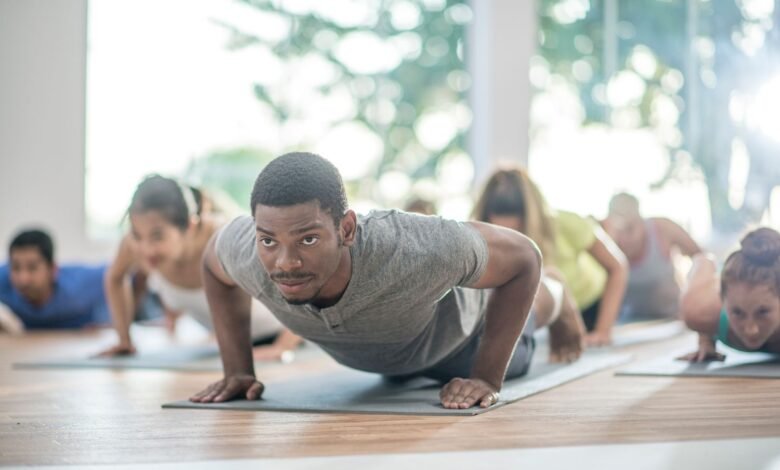Are Competitive Group Fitness Classes Right for You?

Chances are you’ve received the special offers in your inbox for group fitness classes. Or your friends have shared images of their evenings spent at the cute neighborhood boutique gym. Or maybe your city or town offers fitness classes that look inviting and would allow you could get in shape in innovative ways.
But there’s something stopping you from giving group classes a try. While it may sound fun to meet new people and try new workouts, you may worry you will feel embarrassed to exercise with others. Is a competitive culture keeping you away?
If so, you’re not alone. Feeling nervous about competition and experiencing gym intimidation is natural. Fitness classes often bring out people’s competitive nature (or encourage it), but that’s not necessarily a bad thing.
Here you’ll find pros and cons to group fitness competition. Take a look at both sides by examining your personality, overall fitness goals, and what fuels you to work out. This will help you decide if group fitness classes are right for you.
Stats on Group Fitness Classes
According to a Nielsen study of more than 3,000 group fitness classes worldwide, 85% of class members visit a facility or gym twice a week specifically to take a fitness class, and 43% visit a facility four times a week to attend class.
Boutique fitness classes are so popular that they can even bring in anchor tenants. A 2019 review of fitness trends from the American College of Sports Medicine reported that fitness studios can attract other businesses to commercial real estate strip malls.
For example, a company like SoulCycle, an indoor cycling organization giant, brings exercisers into class two to four times a week. These riders could shop or eat at nearby merchants before or after class. Hence the attraction of other similar-minded stores—your target demo is right there already. You might not even need to spend marketing dollars.
Pros of Group Fitness Classes
If you want to try a boutique fitness class, understanding the positive ways competition plays a role in these classes could motivate you to register for one.
Self-Esteem Boost
Competing with others in fitness classes can actually boost your self-esteem rather than hurt it. In a 2016 study published in Scientific Reports on exercising alone versus exercising with others, researchers found that working out with other people provides a strong sense of self-esteem and social capital.
Progress on Goals
Competition can fuel you to achieve your fitness goals faster. According to the American Heart Association, working out with like-minded people, such as those in a boutique barre class, can keep you motivated to accomplish your goals.
Time Spent Outdoors
Exercise can feel less challenging when done outside, even in a competitive setting. For those who dislike the competitive nature of fitness classes, you might want to look at outdoor boutique exercise fitness offerings instead of indoor ones.
A 2013 review of outdoor exercise published in Extreme Physiology & Medicine found that exercising in a natural setting makes exercise feel easier than when inside. Researchers saysthis is due to visual inputs. Looking at nature can act as a distracting stimulus and reduce the perception of exertion.
As a bonus, anyone who feels a sense of danger working out alone in a park or on a trail has the safety net of others when taking an outdoor class.
Motivation to Exercise
Competition beats friendly support for motivating you to exercise. In a 2016 study from the University of Pennsylvania, with funding from the National Cancer Institute’s Center of Excellence in Cancer Communication Research, researchers found that competition truly fuels your exercise.
In an 11-week exercise program, 800 Penn graduate and professional students signed up for weekly classes at the university fitness center. Researchers split these 800 students into four groups: individual competition, team support, team competition, and a control group:
- In the individual group, participants could view leader boards listing anonymous program members. They also earned prizes for their own success in attending classes.
- In the team support group, students used an online format to chat and encourage members to exercise. The most successful teams with class attendance earned rewards.
- In the team competition group, participants could see their team standing.
- In the control group, exercisers simply took classes and received a prize based on their own success.
Results showed overwhelmingly that competition incited participants to exercise. In fact, attendance rates in classes were more than 90% higher in the competitive groups vs. the control group. In the team support group, the exercise rate was half of the competitive groups.
Better Attendance
The competition in fitness classes can get you to show up for class. (Just be sure to not overwhelm yourself at the beginning by doing too much too fast.)
In a 2015 study published in Frontiers in Psychology, researchers at Penn State University developed a fitness routine mimicking the Physical Activity Guidelines for Fitness to determine the effectiveness of group exercise to help onboard members. Fifteen women and 10 men between 25 and 40 years of age completed a 30-week group exercise program.
- There was a six-week familiarization period in which fitness classes were introduced; researchers wanted this to be a slow process and not overwhelm members.
- A 12-week block of six group fitness classes per week of three cardiovascular, two strength, and one flexibility.
- A 12-week block of seven group fitness classes per week of four cardiovascular, two strength, and one flexibility.
Results showed a 98.8% compliance rate, as competition and intrinsic motivation fueled exercise adherence.
Cons of Group Fitness Classes
Working out in one of these ever-growing boutique fitness classes isn’t for everyone. Negative aspects of competition in such classes may result in a loss of interest or participation.
Burnout
Trying to attend every class, beat others’ scores written on leaderboards, compare yourself to the next person—all of this can lead to burnout. This burnout can even bleed into other parts of your life, leading to a joyless existence.
The American Council on Exercise says if these statements ring true, you might be experiencing burnout:
- I’m bored. My job doesn’t excite me anymore.
- Energy? I can barely get out of bed in the morning.
- I would rather be doing something—anything—else.
- I can’t seem to focus or finish a project.
- I’m late to work a lot lately. Some days I just decide not even to go in.
- If I have to listen to one more client’s or coworker’s problems, I just may lose it!
- I can’t relax enough to unwind or even sleep.
- I feel depressed.
- I’m using drugs or alcohol to help me through this time.
If any of these “I” statements describe you, you should scale back your exercise regime and work on a plan of action instead.
Body Dysmorphic Disorder
Body dysmorphia can become worse in group fitness classes. When competing with others who look more in shape than you, body dysmorphic disorder can exacerbate. If you experience this disorder, you might want to speak with a medical professional before entering into an exercise class that is competition-heavy.
Body dysmorphia is prevalent. In a 2019 study published in PLOS One, researchers examined image-related psychopathological disorders using a large cross-sectional sample of 1,711 people. They found that 38.5% or people (about half of them female) were at risk of body dysmorphic disorder.
Nearly 40% of individuals in the study reported used fitness-enhancing supplements without medical consultation. You should make sure your mental health is in check before seeking out an environment that could make you feel worse.
Risk of Injury
If you are constantly competing against the next person, you could become injured as you don’t often think of your own limitations. If the person next to you spins faster and at a higher resistance, you could end up turning up the dial and instead go home with shin splints.
In a review of 2,873 cases of workout injuries published in Injury Epidemiology, 36.2% of all cases were due to overexertion. Sometimes, it’s safer to only compete with yourself.
Cost
The price of a class can amplify your inferiority to those wealthier than you, which is not a good kind of competition. How? One 45- to 60-minute class can equal the price of a month’s gym membership.
So, for the budget-conscious, shelling out upward of $40 per class can feel extremely excessive. Most franchise gyms cost between $30 to $40 per month and offer their own fitness classes, which are inclusive of the price.
Top Group Fitness Studios
If you do decide that a boutique fitness class is right for you, these organizations offer classes you might want to try.
SoulCycle
This indoor cycling organization uses high-energy music and motivating instructors to push riders through a workout in a dark, candlelit setting.
Flywheel
This organization offers another party-type cycling atmosphere similar to SoulCycle but ups the competition level. Riders can hook up to a TorqBoard to track their progress and compete against others in the class. Instructors also come up with various challenges to make the session more challenging and interesting.
According to the Association of Fitness Studios, cycling classes are the most popular boutique fitness classes. They generate 55% more revenue than other fitness studios.
PureBarre
Exercisers attend a Pure Barre class for its combination of postures inspired by ballet, yoga, and Pilates. You use a barre for balance, just as a ballerina would. But you don’t need a ballet background to succeed in class.
Orangetheory Fitness
In each 60-minute class, you’ll train using a high-intensity interval workout (HIIT) format, cycling through treadmill, rower, and floor exercises. Each class focuses on a specific type of training: endurance features long lengths of time on the treadmill and high reps on the floor, strength classes have uphill climbs on a treadmill and heavy weights on the floor, and power classes work on speed.
CorePower Yoga
The largest yoga studio chain in the U.S., CorePower Yoga touts itself as a yoga studio offering modern, spacious environments with mindful, highly physical workouts that use every muscle in the body.
SolidCore
This fitness organization created a riff on the traditional Pilates reformer to activate slow-twitch muscle fibers. Participants move the body about an inch at a time, much slower than other Pilates classes.
Club Pilates
A new take on Pilates, you can work your core with slow, steady Pilates sessions in this novel hybrid format.
A Word From Verywell
If these pros of group fitness classes helped you learn that a competitive group setting sounds perfect for you, that’s great! However, if you’re still not convinced that competitive culture will help you feel motivated or comfortable in a group fitness class, that’s OK too.
Don’t put any extra pressure on yourself to try something new or get into a boutique studio if it doesn’t feel quite right. However you choose to work out, make sure it makes you feel good—physically and mentally.




